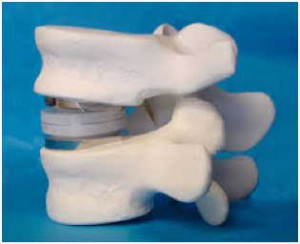Cervical Disc Replacement–One Level
 Cervical Disk Replacement Surgery One Level involves removing a diseased cervical disk and replacing it with an artificial disk. It is done when the space between your vertebrae has become too narrow and part of your vertebrae or your cervical disk is pressing on your spinal cord or spinal nerves, causing you pain, numbness, or weakness. When these symptoms do not respond to nonsurgical types of treatment, disk surgery may be recommended. Cervical Disc Replacement One Level procedure involves the removal and replacement of one Level (One Disc).
Cervical Disk Replacement Surgery One Level involves removing a diseased cervical disk and replacing it with an artificial disk. It is done when the space between your vertebrae has become too narrow and part of your vertebrae or your cervical disk is pressing on your spinal cord or spinal nerves, causing you pain, numbness, or weakness. When these symptoms do not respond to nonsurgical types of treatment, disk surgery may be recommended. Cervical Disc Replacement One Level procedure involves the removal and replacement of one Level (One Disc).
Before the procedure
In the days before your surgery, tell your surgeon about any medications you take at home including herbal supplements and over-the-counter medications. You may be asked to stop taking aspirin or other medications that thin your blood and may increase bleeding.
- Tell your surgeon if you or someone in your family has any history of reaction to general anesthesia.
- If you smoke, you may be asked to stop smoking well before surgery and avoid smoking for a period of time after surgery.
- Before surgery you will probably be given instructions on when to stop eating and drinking. It’s common to have nothing to eat or drink after midnight on the night before the procedure.
- Ask your surgeon if you should take your regular medications with a small sip of water on the day of the procedure
 During the procedure
During the procedure
- Just before the procedure starts you will have an intravenous line (IV) started so you can receive fluids and medications to make you relaxed and sleepy. This procedure is usually done under general anesthesia (you are asleep). Medication may be given through the IV to put you to sleep and a tube may be inserted in your throat to protect your airway and supplement your breathing. The actual procedure may last a few hours. This is what may happen once the procedure begins:
- Monitors are placed to check your heart, blood pressure, and oxygen level.
- The area of your neck where the incision will be made is cleaned with a special solution to kill germs on the skin.
- A one- to two-inch incision (surgical cut) is made on the side or front of your neck.
- The important structures of the neck are carefully moved to the side until the surgeon can see the bones of the vertebrae and the cervical disk.
- The cervical disk that is being replaced is removed.
- The artificial disk is placed into the empty disk space.
- The incision is closed using absorbable sutures (stitches) under the skin.
- The skin is then carefully closed with sutures that minimize any scarring.
- A small dressing is applied over the incision, a rigid or soft neck collar may be put on your neck, and you will be taken to the recovery area.
After the procedure
- In the recovery area, you will be observed until you recover from the anesthesia. Pain after disk replacement surgery is normal and you may be given pain medication in the recovery area.
- You’ll continue to take pain medication if you need it.
- You may be given a support collar to wear in the hospital.
- You will be encouraged to get out of bed and move around as soon as you are able to.
- Recovery and rehabilitation at home may be a little different for each person, but in general, here’s what you might expect:
- You may need to continue wearing a soft or rigid neck support.
- You will be able to eat your normal diet.
- You may need to return to your surgeon to have sutures removed.
- You will gradually start returning to normal activities.
- You should ask your surgeon about any activity restrictions and when you can take a regular shower or bath.
- You may start physical therapy after a few weeks.
- You should be able to return to full activities by four to six weeks.
Risks of the procedure
Disk replacement surgery is a safe procedure, but all surgeries carry some risks. You will need to sign a consent form that explains the risks and benefits of the surgery.
- Some potential risks of cervical spine surgery include:
- Reactions to the anesthesia
- Bleeding
- Infection
- Nerve injury Spinal fluid leak
- Voice change
- loosened artificial disk Need for further surgery
There may be other risks, depending on your specific medical condition. Be sure to discuss any concerns with your surgeon before the procedure.
